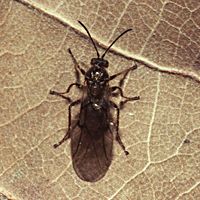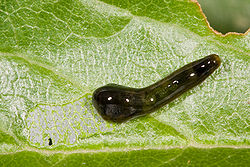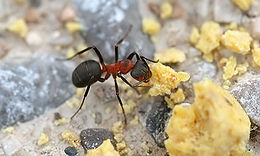
Hymenoptera in the 10th edition of Systema Naturae
Encyclopedia
In the 10th edition of Systema Naturae, Carl Linnaeus classified the arthropod
s, including insect
s, arachnid
s and crustacean
s, among his class "Insecta". Insects with membranous wings, including bee
s, wasp
s and ant
s were brought together under the name Hymenoptera.
Cynips (gall wasp

Tenthredo (sawflies

Sphex (digger wasp
Vespa (hornet
Apis (bee
Formica (ant

Mutilla (velvet ants
Arthropod
An arthropod is an invertebrate animal having an exoskeleton , a segmented body, and jointed appendages. Arthropods are members of the phylum Arthropoda , and include the insects, arachnids, crustaceans, and others...
s, including insect
Insect
Insects are a class of living creatures within the arthropods that have a chitinous exoskeleton, a three-part body , three pairs of jointed legs, compound eyes, and two antennae...
s, arachnid
Arachnid
Arachnids are a class of joint-legged invertebrate animals in the subphylum Chelicerata. All arachnids have eight legs, although in some species the front pair may convert to a sensory function. The term is derived from the Greek words , meaning "spider".Almost all extant arachnids are terrestrial...
s and crustacean
Crustacean
Crustaceans form a very large group of arthropods, usually treated as a subphylum, which includes such familiar animals as crabs, lobsters, crayfish, shrimp, krill and barnacles. The 50,000 described species range in size from Stygotantulus stocki at , to the Japanese spider crab with a leg span...
s, among his class "Insecta". Insects with membranous wings, including bee
Bee
Bees are flying insects closely related to wasps and ants, and are known for their role in pollination and for producing honey and beeswax. Bees are a monophyletic lineage within the superfamily Apoidea, presently classified by the unranked taxon name Anthophila...
s, wasp
Wasp
The term wasp is typically defined as any insect of the order Hymenoptera and suborder Apocrita that is neither a bee nor an ant. Almost every pest insect species has at least one wasp species that preys upon it or parasitizes it, making wasps critically important in natural control of their...
s and ant
Ant
Ants are social insects of the family Formicidae and, along with the related wasps and bees, belong to the order Hymenoptera. Ants evolved from wasp-like ancestors in the mid-Cretaceous period between 110 and 130 million years ago and diversified after the rise of flowering plants. More than...
s were brought together under the name Hymenoptera.
Cynips (gall waspGall waspGall wasps , also called Gallflies, are a family of the order Hymenoptera and are classified with the Apocrita suborder of wasps in the superfamily Cynipoidea...
s)

- Cynips rosae – Diplolepis rosae
- Cynips hieracii – Aulacidea hieracii
- Cynips glechomae – Liposthenes glechomae
- Cynips quercus baccarum – Neuroterus quercusbaccarumNeuroterus quercusbaccarumThe common spangle gall on the underside of leaves and the currant gall on the male catkins or occasionally the leaves, develop as chemically induced distortions on pedunculate oak , or sessile oak trees, caused by the cynipid wasp Neuroterus quercusbaccarum which has both agamic and bisexual...
- Cynips quercus folii – Cynips quercusfoliiCynips quercusfoliiCynips quercusfolii is a gall wasp species in the genus Cynips. The species is important for the production of commercial nutgall formed on Quercus lusitanica ....
- Cynips quercus petioli
- Cynips quercus pedunculi
- Cynips quercus gemmae
- Cynips fagi
- Cynips viminalis
- Cynips salicis strobili
- Cynips amerinae – Euura amerinae
- Cynips psenes – Blastophaga psenes
- Cynips sycomori – Sycophaga sycomori
Tenthredo (sawfliesSawflySawfly is the common name for insects belonging to suborder Symphyta of the order Hymenoptera. Sawflies are distinguishable from most other Hymenoptera by the broad connection between the abdomen and the thorax, and by their caterpillar-like larvae...
)

- Tenthredo femorata - Cimbex femoratus
- Tenthredo lutea - Cimbex luteus
- Tenthredo amerinae - Pseudoclavellaria amerinae
- Tenthredo lucorum - Trichiosoma lucorum
- Tenthredo fasciata - Abia fasciata
- Tenthredo americana – Incalia americana
- Tenthredo nitens – Abia nitens
- Tenthredo pini - Diprion pini
- Tenthredo juniperi - Monoctenus juniperi
- Tenthredo ustulata - Arge ustulata
- Tenthredo rustica - Arge rustica
- Tenthredo scrophulariae
- Tenthredo pratensis - Dolerus pratensis
- Tenthredo cerasi - Caliroa cerasi
- Tenthredo salicis - Nematus salicis
- Tenthredo mesomela
- Tenthredo rufipes - Macrophya rufipes
- Tenthredo campestris
- Tenthredo atra - Tenthredella atra
- Tenthredo viridis - Rhogogaster viridis
- Tenthredo rosae - Athalia rosae
- Tenthredo cincta - Allantus cinctus
- Tenthredo lividaTenthredo lividaTenthredo livida, a Common Sawfly, is a species belonging to the family Tenthredinidae subfamily Tenthrediniinae. This species is present in most of Europe....
- Tenthredo septentrionalis - Craesus septentrionalis
- Tenthredo 12-punctata - Macrophya duodecimpunctata
- Tenthredo erythrocephala - Acantholyda erythrocephala
- Tenthredo abietis - Cephalcia abietis
- Tenthredo sylvatica - Pamphilus sylvaticus
- Tenthredo nemoralis - Neurotoma nemoralis
- Tenthredo cynosbati – ?
- Tenthredo reticulata - Caenolyda reticulata
- Tenthredo betulae - Pamphilus betulae
- Tenthredo saltuum - Neurotoma saltuum
- Tenthredo intercus – ?
- Tenthredo rumicis - Polynematus annulatus
- Tenthredo ulmi - Cladius ulmi
- Tenthredo alni - Craesus septentrionalis
- Tenthredo pruni - Pareophora pruni
- Tenthredo lonicerae - Abia lonicerae
- Tenthredo capreae - Nematus salicis
Ichneumon (ichneumon wasps)
- Ichneumon gigas
- Ichneumon spectrum – Xeris spectrumXeris spectrumXeris spectrum is a kind of horntail or wood wasp, that lives in coniferous forests. It is large wasp with a powerful ovipositor in females. Unlike other Siricid Wood wasps, Xeris spectrum does not have symbiotic fungi to aid its larvae as they burrow in the wood of fir and other conifer trees...
- Ichneumon juvencus – Sirex juvencusSirex juvencusSirex juvencus is a wasp that can be found in Europe, Siberia, Sakhalin Island, Japan, the Philippines, Algeria, New Zealand, and several other countries. Its common name is steely-blue wood wasp because of its colour.-Description:...
- Ichneumon camelus
- Ichneumon ugillatorius
- Ichneumon raptorius – Diphyus raptorius
- Ichneumon sarcitorius – Ichneumon sarcitorius
- Ichneumon extensorius
- Ichneumon culpatorius – Probolus culpatorius
- Ichneumon constrictorius
- Ichneumon saturatorius – Vulgichneumon saturatorius
- Ichneumon crispatorius – Eutanyacra crispatorius
- Ichneumon pisorius
- Ichneumon luctatorius – Diphyus luctatorius
- Ichneumon volutatorius – Banchus volutatorius
- Ichneumon vaginatorius
- Ichneumon persvasorius – Rhyssa persuasoriaRhyssa persuasoriaRhyssa persuasoria, the Giant Ichneumon, is a species belonging to the family Ichneumonidae subfamily Rhyssinae.It is found in most of Europe, in the Australasian ecozone, in the Near East, in the Nearctic ecozone, in North Africa and in the Oriental ecozone.Rhyssa persuasoria is one of the...
- Ichneumon designatorius
- Ichneumon edictorius – Ctenichneumon edictorius
- Ichneumon deliratorius – Coelichneumon deliratorius
- Ichneumon fossorius
- Ichneumon ariolator
- Ichneumon comitator – Coelichneumon comitator
- Ichneumon peregrinator – Barichneumon peregrinator
- Ichneumon incubitor – Gambrus incubitor
- Ichneumon reluctator – Echthrus reluctator
- Ichneumon denigrator
- Ichneumon desertor
- Ichneumon coruscator – Cratichneumon coruscator
- Ichneumon manifestator – Ephialtes manifestator
- Ichneumon compunctor – Apechthis compunctor
- Ichneumon delusor – Syntactus delusor
- Ichneumon venator
- Ichneumon extensor
- Ichneumon exarator
- Ichneumon turionellae – Pimpla turionellae
- Ichneumon strobilellae
- Ichneumon moderator
- Ichneumon resinellae
- Ichneumon praerogator
- Ichneumon mandator – Agrothereutes mandator
- Ichneumon titillator – Meringopus titillator
- Ichneumon enervator
- Ichneumon gravidator
- Ichneumon inculcator – Itamoplex inculcator
- Ichneumon pugillator – Dusona pugillator
- Ichneumon ruspator
- Ichneumon jaculator
- Ichneumon assectator
- Ichneumon appendigaster
- Ichneumon luteus – Ophion luteus
- Ichneumon ramidulus – Enicospilus ramidulus
- Ichneumon glaucopterus – Opheltes glaucopterus
- Ichneumon circumflexus – Therion circumfiexum
- Ichneumon cinctus – Gelis cinctus
- Ichneumon muscarum
- Ichneumon bedeguaris
- Ichneumon juniperi
- Ichneumon puparum
- Ichneumon larvarum
- Ichneumon cyniphidis
- Ichneumon coccorum
- Ichneumon secalis
- Ichneumon subcutaneus
- Ichneumon aphidum
- Ichneumon ovulorum
- Ichneumon globatus
- Ichneumon glomeratus
- Ichneumon pectinicornis
Sphex (digger waspDigger waspWasps of the genus Sphex are cosmopolitan predators of the family Sphecidae that sting and paralyze prey insects. There are over 130 known digger wasp species. In preparation for egg laying, they construct a protected "nest" and then stock it with captured insects...
s)
- Sphex argillacea – Zeta argillaceumZeta argillaceumZeta argillaceum is one of the most common species of potter wasp in South America. It is found throughout the continent and as far north as Mexico and the southern United States ....
- Sphex sabulosa
- Sphex asiatica – Sceliphron asiaticum
- Sphex fervens
- Sphex inda
- Sphex clavipes
- Sphex spirifex & Sphex aegyptia – Sceliphron spirifexSceliphron spirifexSceliphron spirifex is a species of sphecid wasp. It has a medium sized body , which is dull black with a long, yellow petiole . The legs are black with yellow bands, the antennae are black and the wings are clear....
- Sphex figulus
- Sphex viatica
- Sphex pectinipes
- Sphex variegata
- Sphex indica
- Sphex tropica
- Sphex colon
- Sphex gibba
- Sphex rufipes
- Sphex arenaria
- Sphex fossoria
- Sphex leucostoma
- Sphex vaga
- Sphex caerulea
- Sphex ignita
- Sphex aurata
- Sphex cyanea
Vespa (hornetHornetHornets are the largest eusocial wasps; some species can reach up to in length. The true hornets make up the genus Vespa and are distinguished from other vespines by the width of the vertex , which is proportionally larger in Vespa and by the anteriorly rounded gasters .- Life cycle :In...
s & waspWaspThe term wasp is typically defined as any insect of the order Hymenoptera and suborder Apocrita that is neither a bee nor an ant. Almost every pest insect species has at least one wasp species that preys upon it or parasitizes it, making wasps critically important in natural control of their...
s)
- Vespa crabro – European hornetEuropean hornetThe European hornet Vespa crabro, commonly known simply as the "hornet", is the largest European eusocial wasp. The queen measures 25 to 50 mm long; males and workers are smaller...
- Vespa vulgaris – Vespula vulgaris, common wasp
- Vespa rufa – Vespula rufa
- Vespa parietum
- Vespa muraria
- Vespa cribraria
- Vespa spinipes
- Vespa rupestris
- Vespa coarctata
- Vespa arvensis
- Vespa biglumis
- Vespa uniglumis
- Vespa cornuta
- Vespa signata
- Vespa canadensis
- Vespa emarginata
- Vespa calida
Apis (beeBeeBees are flying insects closely related to wasps and ants, and are known for their role in pollination and for producing honey and beeswax. Bees are a monophyletic lineage within the superfamily Apoidea, presently classified by the unranked taxon name Anthophila...
s)
- Apis longicornis
- Apis tumulorum
- Apis clavicornis
- Apis centuncularis
- Apis cineraria
- Apis surinamensis – Eufriesea surinamensis
- Apis retusa
- Apis rufa
- Apis bicornis
- Apis truncorum
- Apis dentata – Exaerete dentata
- Apis cordata – Euglossa cordata
- Apis helvola
- Apis succincta
- Apis zonata
- Apis caerulescens
- Apis mellifera – Western honey bee
- Apis subterranea
- Apis variegata
- Apis rostrata
- Apis manicata
- Apis quadridentata
- Apis florisomuis
- Apis conica
- Apis annulata
- Apis ruficornis
- Apis ichneumonea
- Apis cariosa
- Apis violacea – Xylocopa violaceaXylocopa violaceaXylocopa violacea, the violet carpenter bee, is the common European species of carpenter bee, and one of the largest bees in Europe. Like most members of the genus Xylocopa, it makes its nests in dead wood....
, violet carpenter bee - Apis terrestris – Bombus terrestrisBombus terrestrisBombus terrestris, the buff-tailed bumblebee or large earth bumblebee is one of the most numerous bumblebee species in Europe. The queen is 2–2.7 cm long, while the workers are 1½–2 cm...
, buff-tailed bumblebee - Apis lapidaria – Bombus lapidariusBombus lapidariusBombus lapidarius, the Red-tailed bumblebee, is a species of bumblebee in the subgenus Melanobombus.-Characteristics:Red-tailed bumblebees are mostly coloured black, the hind-quarters are auburn red though. Male exemplars feature a yellow band on their chest...
, red-tailed bumblebee - Apis muscorum
- Apis hypnorum – Bombus hypnorumBombus hypnorumBombus hypnorum, the tree bumblebee or new garden bumblebee, is a species of bumblebee. It is one of the most common bumblebee species in north and eastern Europe, but it's less common past 70 degrees north. Its distribution ranges over most of Europe and parts of Eastern Asia, although less common...
, new garden bumblebee - Apis acervorum
- Apis subterranea – Bombus subterraneusBombus subterraneusThe short-haired bumblebee or short-haired humble-bee, Bombus subterraneus, is a species of bumblebee found in Eurasia, Southern Asia and Australia, as well as in New Zealand, where it is an introduced species....
, short-haired bumblebee - Apis surinamensis
- Apis aestuans
- Apis tropica
- Apis alpina – Bombus alpinusBombus alpinusBombus alpinus is a species of bumblebee. It is found in Eurasia....
Formica (antAntAnts are social insects of the family Formicidae and, along with the related wasps and bees, belong to the order Hymenoptera. Ants evolved from wasp-like ancestors in the mid-Cretaceous period between 110 and 130 million years ago and diversified after the rise of flowering plants. More than...
s)

- Formica herculeana – Camponotus herculeana
- Formica rufaFormica rufaFormica rufa, also known as the southern wood ant or horse ant, is a boreal member of the Formica rufa group of ants, commonly found throughout much of Europe in both coniferous and broad-leaf broken woodland and parkland. Workers can measure 8–10 mm in length...
- Formica fuscaFormica fuscaFormica fusca, the common black ant of Europe, is a palaearctic ant with a range extending from Portugal in the west to Japan in the east and from Italy in the south to Fennoscandia in the north. F...
- Formica nigra – Lasius nigra
- Formica obsoleta
- Formica rubra – Myrmica rubraMyrmica rubraMyrmica rubra, also known as the European fire ant or common red ant, is a species of ant of the genus Myrmica, found all over Europe and in some parts of North America and Asia. They are mainly red in colour, with slightly darker pigmentation on the head. The ants live under stones, fallen trees,...
- Formica pharaonis – Monomorium pharaonis
- Formica salomonis – Monomorium salomonis
- Formica saccharivora
- Formica caespitum – Tetramorium caespitum
- Formica omnivora
- Formica bidens – Dolichoderus bidens
- Formica sexdens – Atta sexdensAtta sexdensAtta sexdens is a species of leafcutter ant belonging to the tribe Attini. Atta species are native to the New World, from Southern United States to Northern Argentina in the South. They are absent from Chile. They cut leaves to provide a substrate for the fungus farms which are their principal...
- Formica cephalotes – Atta cephalotesAtta cephalotesAtta cephalotes is one of 41 species of leafcutter ant. This species is part of the Attini tribe . A single colony of ants can contain up to 5 million members, and each colony has one queen that can live more than 15 years...
- Formica atrata – Cephalotes atratus
- Formica haematoda – Odontomachus haematodus
- Formica foetida – Pachycondyla foetida
Mutilla (velvet antsMutillidaeMutillidae are a family of more than 3,000 species of wasp whose wingless females resemble ants. Their common name velvet ant refers to their dense pile of hair which most often is bright scarlet or orange but may also be black, white, silver, or gold. Their bright colours serve as aposematic signals...
)
- Mutilla occidentalis – Dasymutilla occidentalisDasymutilla occidentalisDasymutilla occidentalis, commonly known as the Eastern Velvet Ant or Red Velvet Ant, is a species of parasitoid wasp that is native to the eastern United States. Commonly mistaken for a member of the true ant family, the female is wingless. The species ranges from Connecticut to Missouri in the...
- Mutilla americana – Traumatomutilla americana
- Mutilla indica
- Mutilla europaea
- Mutilla barbara – Ronisia barbara
- Mutilla maura – Dasylabris maura
- Mutilla acarorum – Gelis acarorum
- Mutilla formicaria – Gelis formicarius

